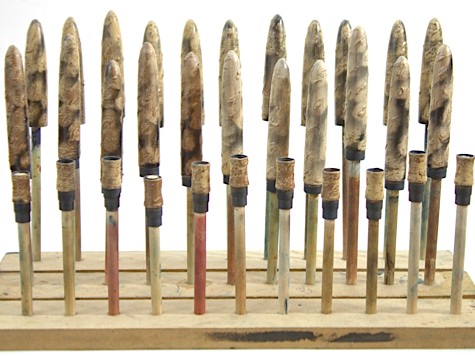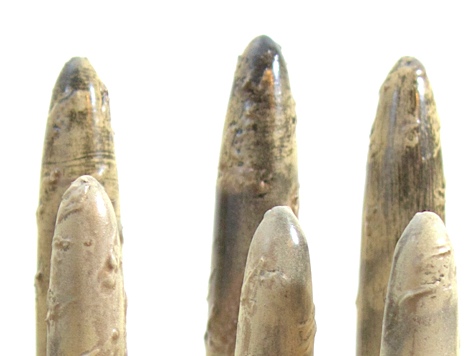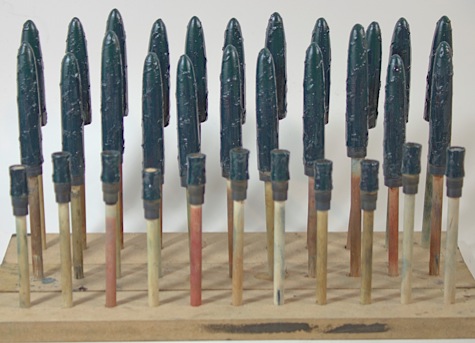Urushi Herald Project
Updated 8/8/2011 – The project is finished! There are no longer pens available.
The Edison Pen Company is proud to announce it’s second collaborative project with Ernest Shin, of Hakumin Urushi Kobo.
Twenty Limited Edition Heralds are currently in production.
The technique to be used with this edition is similar in ways to the technique used on the Urushi Pearl project with several key differences in how the mottling is applied and in the pigmentation of the lacquer. Even with the differences, the technique can be considered a Kara-nuri technique. The lacquer used to produce the textured under layer as well as the over-layers this time were pigmented with a carefully chosen mixture of traditional and modern pigments to produce a teal blue color that would not darken excessively while curing and would maintain the hardness and durability that urushi is known for. The under layers, this time produced by using rehydrated albumen powder, was applied in a distinct pattern, covered with 23.5k gold powder and then covered over with several layers of pigmented lacquer.
The pen will be a clipless Herald made from ebonite, with an 18k gold nib. The nib can be F, M, or B. I can also customize the nib to any specification. The filling system will be a cartridge/converter and/or eyedropper in the same pen.
Below are photos showing examples of the Urushi technique by Hakumin Urushi that will be used on the Heralds….


So the Heralds will have a finish identical to what you see above.
Below is a photo of the clipless Herald pen that this technique will be applied to….

Price of the pen is $825. Since the project requires 4 months, customers can pay an additional amount per month, or pay the balance upon completion.
The limited edition is going to be twenty pens.
ALL PENS ARE SOLD.
If you would like to bookmark this page, progress photos and videos are below, and the entire process will be documented and updated on a regular basis. If you would like to see an example of how the process will be documented, visit the Urushi Pearl Project Page.
Thanks!
Brian at Edison and Ernest at Hakumin Urushi
12.28.10
The pens are off the lathe and rough sanded. They are now on the way to Hakumin Urushi Kobo for lacquer treatment.

2.3.2011
Pens Mounted
Photo of the unlacquered pens mounted and ready for lacquering. The pens are first washed in with water and detergent and then the parts are fitted onto dowel and then fitted into a base. The parts will be removed or mounted as needed during the lacquer process.

Katame
Ebonite hardening. The first layer of lacquer. Ki-urushi (raw lacquer) is vigorously rubbed into the surface of the ebonite impregnate the surface thoroughly. Excess lacquer is wiped off and the pens are cured for a day in the furo (curing cabinet). When used with a wood substrate, this process is used to harden and seal the wood surface and to prevent absorption of subsequent layers of lacquer, but with ebonite, which doesn’t need hardening or sealing it helps subsequent layers of lacquer adhere better over the long run. The process is completed twice.

Nakanuri Wet

Nakanuri Cured
The first layer of the naka-nuri (middle layers). These layers are applied to give substance and strength to the lacquerwork prior to applying the decorative layers. The first photo is of the freshly applied kuro nakanuri urushi prior to curing, and the second layer is after curing. Each of the several layers applied are sanded in between to provide proper adhesion and to smooth out the layers.

Shibo Urushi Application
As with the Pearl project, the shibo urushi step is the first step that is unique to the the decorative technique for these pens. The technique involves applying a layer of shibo-urushi unevenly. Shibo urushi is urushi mixed with a stiffener, or thickener, which in this case is also egg whites. Once the egg whites are thoroughly mixed in to the lacquer, it is applied in a distinctive pattern onto the surface of the pens, making sure that the layer is not too thick. The shibo urushi mixture for this project uses a blue pigmented lacquer rather than the black of the Pearl Project. After application, the layer is cured for 72 hours at a low humidity then for an extended period of several days in the standard humid curing environment.


3.11.11
Iro Urushi:
After the shibo urushi fully cures, a layer of colored urushi is applied over the entire surface.
.jpg)
.jpg)
Tsuma-Nuri:
Once the iro-urushi layer is cured, it is time to apply the gold powder. Unlike the pearl project where the gold powder would be visible through the transparent urushi, only the places where the powder is exposed through sanding will be visible in this technique. Because of this, the gold powder is only applied on the peaks where the shibo-urushi had been applied. The gold powder here is a mixture of 24 K powder with a small amount of fine silver powder to create a slightly lighter shade of gold called ao-kin, or blue gold. Once the urushi cures and the gold powder adheres firmly, the upper layers of color will be applied.


5.4.11
Agenuri
After the gold powder accent layer, several more layers of blue lacquer are applied. Two slightly different shades of blue are used for these upper layers to give a contrast between a darker and a lighter blue in the finished product. 6 layers, three of each shade is applied in total.

Mizutogi
After the upper layers of lacquer are fully cured, it is finally time for sanding. The layers are carefully sanded down using a series of sandpapers to reveal what is close to the final patterning.

Mizutogi
Initially, the layers are sanded back with a coarser grit to level out the surface (right), and afterwards with a finer grit (left). After this sanding, the pens are washed, and placed in the curing cabinet for another couple days to ensure that the surface is as hard as possible. Now, it’s time for polishing!

8.8.11
FINISHED!





Thanks!
